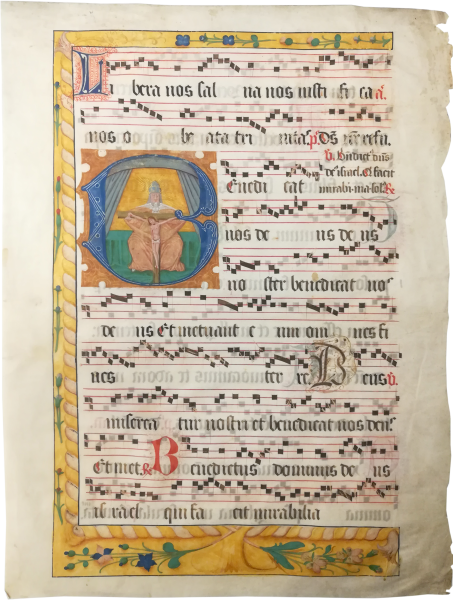


Master of Raphaël de Mercatellis Group (active Ghent and Bruges, 1470–1510)
, Flanders, Ghent or Bruges, c. 1470–1510Master of Raphaël de Mercatellis Group (active Ghent and Bruges, 1470–1510)
Description
This full-page painting opened the Hours of the Cross in a Flemish Book of Hours, as indicated by the rubric near the center of the page: Het cruus ghetide. The central panel depicts a scene from the Passion in which Pilate presents the flagellated Christ to a riotous crowd with the words “Ecce Homo” (“Behold the Man”). An historiated frame around the central image depicts the preceding narrative scenes: Christ praying in the garden of Gethsemane while the apostles sleep, Christ in the court of King Herod, and the Flagellation. The style of painting is related to the Masters of Raphaël de Mercatellis group. These were illuminators in various workshops located in Ghent and Bruges in the late 15th and early 16th centuries who emulated the work of Flemish masters such as Simon Bening (1483–1561). Raphaël de Mercatellis (1437–1508), one of the non-marital children of Duke Philip of Burgundy (1396–1467), became abbot of St. Bavo’s in Ghent in 1478. He patronized artists in colloquial workshops while assembling his library, rather than commissioning paintings from celebrated, and more expensive, master illuminators.
This page bears several similarities to the Rokeghem Hours (Bruges, c. 1500), attributed to the Masters of Raphaël de Mercatellis group, and previously in the collection of Les Enluminures (BOH 07).Correlations with the “Ecce Homo” page, particularly the style of its distinctive red-lipped figures, are found in the Raising of Lazarus miniature in the Rokeghem Hours (fol. 87v, see figure 1). The Rokeghem Hours also contains a page with an historiated border (fol. 20r, see figure 2), and its uneven script is similar to that on the text side of the “Ecce Homo” page. The “Ecce Homo” is unusual subject matter to precede the Hours of the Cross, which is customarily opened by an image of the Crucifixion.
Also unusual for a Book of Hours is the inclusion of a prayer to the Holy Face, as is inscribed on the text side of this page: Veronice ymaginem tuam sudario impressam relinquere voluisti, per crucem et passionem tuam nobis tribue ut ita in terris per speculum in enigmate venerari adorare honorare ipsam valeamus, ut te tunc facie ad faciem venientem super nos iudicem securi videre mereamur. Qui vivis et regnas deus, per omnia secula secularum. Amen. The prayer to the Holy Face is thematically connected to the painted side by the image of the Sudarium, Veronica’s veil on which the face of Christ was supernaturally imprinted during the Passion, located in the Flagellation scene. The text side of the page is marked with modern pencil and pen notations at the upper and lower edges, as well as adhesive residue from previous mounting, particularly along the upper edge.
We are grateful to Anne Margreet As-Vijvers and James Marrow for their expertise.
Related manuscripts:
The Rokegham Hours, c. 1500, previously in the collection of Les Enluminures, BOH 07
Cornelia van Wulfshkercke, Book of Hours, c. 1510–1519, Brussels, KBR, Ms. IV (https://opac.kbr.be/LIBRARY/doc/SYRACUSE/16785470)
Comparative manuscript
Book of Hours, c. 1510–1520, Syracuse, NY, Syracuse University LIbrary MS 7 (https://library.syracuse.edu/extsites/mm/manuscript7.php#details)
Provenance
Estate of Isidor Kaiser, Copenhagen-Hamburg
Literature
Unpublished. For comparisons and further reading, see:
D. Vanwijnsberghe, “L’Antiphonaire d’Oosteeklo et son enlumineur (Cornelia van Wulfschkercke ?),” in Mélanges en l’honneur de Roger Marijnissen, online publication, 2013:
https://doi.org/10.4000/ceroart.4749
A.M. As-Vjivers, “ManuscriptProduction in a Carmelite Convent: The Case of Cornelia van Wulfskercke,” in: Books of Hours Reconsidered, eds. S. Hindman and J.H. Marrow, London and Turnhout, 2013, pp. 279–296.
— Re-Making the Margin: The Master of the David Scenes and Flemish Manuscript Painting around 1500, trans. Diane Webb. Turnhout, 2013.
G. Dogaer and J.H. Marrow, Flemish Miniature Painting in the 15th and 16th Centuries, Amsterdam, 1987.
